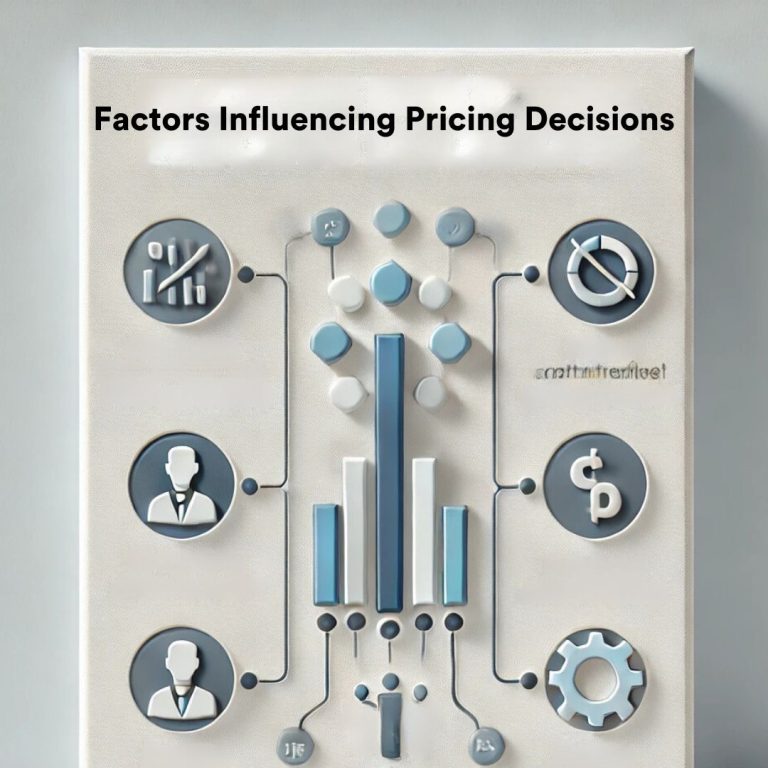Factors Affecting Pricing Decisions: Factors that affect pricing decisions determine the cost for which products or services are sold to their customers in the market. Factors affecting the price guide organizations concerning the ideal price to charge in order to realize maximum profitability while satisfying the expectations of consumers and remaining competitive in the market. Strategic pricing is one of the paramount platforms by which an organization can position itself in the market so as to realize its business objectives.
What is Price in Marketing?
Price in marketing is the money a customer ought to pay for the acquisition of the product or service. It forms a very important part of the marketing mix where price has an impact on the impression, demand of the company, and finally its revenue and profitability. Pricing goes far beyond being just a number; it’s always considered to represent the value the customer finds in the product that makes them buy it.
- Value Perception: How much a customer believes the product or service is worth.
- Market Demand: Determines how willing customers are to pay a certain price.
- Competitive Analysis: Evaluating what competitors charge for similar products or services.
Pricing directly impacts a company’s market share and revenue, making it one of the most critical aspects of its marketing strategy.
Types of Pricing Methods
For instance, to establish a competitive price, one needs to understand the various kinds of pricing methods. Each method involves various criteria in terms of costs, market conditions, customer preferences, and competitive landscape.
Common Pricing Methods
Each pricing method has its advantages and challenges, and the choice of method depends on the company’s goals and market conditions.
- Cost-Plus Pricing: Price is determined by adding a markup to the product’s cost. Simple and ensures that all production costs are covered.
- Value-Based Pricing: Sets the price based on the perceived value of the product or service to the customer. Useful for unique products with a strong brand reputation.
- Competitive Pricing: Prices are set based on what competitors are charging for similar products. Effective in highly competitive markets where price wars are common.
- Dynamic Pricing: Prices are adjusted in real-time based on market demand, competition, and other external factors. Commonly used in e-commerce, airlines, and hospitality industries.
Factors Influencing Pricing
Diverse, often internal and external, features that have an impact on the strategy adopted by a firm in determining its pricing influence factors affecting the decisions of a company. These elements guide how a price is set with the intent of being competitive, profitable, and attractive.
These factors help businesses create a balanced pricing strategy that aligns with their financial objectives and market dynamics.
- Cost of Production: The primary factor in pricing is the cost of raw materials, labor, and overhead expenses. Businesses must ensure that prices cover all costs and generate a reasonable profit margin.
- Market Demand: The demand for a product or service greatly impacts its pricing. High demand allows for higher pricing, while low demand often requires discounts to attract buyers.
- Competition: The presence of competitors in the market can influence how a company prices its products. Businesses may need to match or undercut competitors’ prices to maintain market share.
- Consumer Perception: Prices are set based on the perceived value of the product in the eyes of the consumer. Premium products can command higher prices they are perceived as higher quality or exclusive.
- Economic Conditions: Inflation rates, economic stability, and purchasing power of consumers impact pricing decisions. During economic downturns, businesses may reduce prices to maintain sales volume.
Determinants of Price in Marketing
Determinants of Price: Detailed information about factors that influence overall pricing strategy. Determinants ensure pricing is aligned with business goals, market conditions, and customer expectations. These knowledge determinants help a company design pricing strategies that are flexible, sustainable, and in line with its market positioning.
- Objectives of Pricing: Companies set prices based on their overall business objectives, such as maximizing profit, increasing market share, or achieving competitive parity. The pricing strategy reflects the company’s priorities and growth plans.
- Product Life Cycle: Prices often change as a product moves through its life cycle stages (introduction, growth, maturity, decline). Introductory prices may be lower to gain market entry, while mature products might have stabilized or reduced pricing.
- Legal and Regulatory Factors: Government regulations and industry standards can impose price controls or restrictions. Compliance with pricing laws ensures that businesses avoid legal penalties and maintain market credibility.
- Distribution Channels: The choice of distribution channels can affect the final price of a product. Direct sales may have lower prices compared to products sold through intermediaries due to reduced costs.
Conclusion
In conclusion, understanding factors that influence pricing decisions is key to strategic and competitive pricing of products or services in a business. Production costs, demand, competitors, and economic factors are some of the factors that influence and determine how a company should set its prices. Applying an appropriate pricing model or method taking into account these determinants enables a company to achieve financial objectives while maintaining customer satisfaction and a better market position.
Factors Influencing Pricing Decisions FAQs
What is price in marketing?
Price in marketing can be defined as the amount of money that a customer pays to attain a product or service which reflects its value and demand in the market.
What are the fundamental factors that determine pricing decisions?
These include the cost of production, demand within the market, competition, perception of the consumers about the product, and the economic conditions.
What are the types of pricing methods?
Traditional methods comprise cost-plus pricing, value-based pricing, competitive pricing, and dynamic pricing.
How are economic conditions reflected in price?
According to economic factors such as inflation, purchasing power, and market stability, business interests in terms of pricing can easily be set or adjusted by it.
Which pricing method is suitable for competitive markets?
Competitive pricing is most appropriate in competitive markets, where businesses often price competitively within a certain level and charge based on what their competitors are charging.


